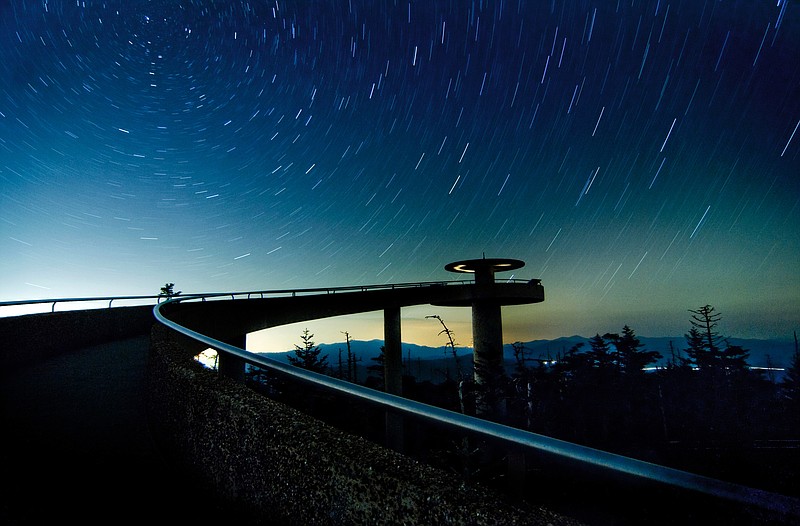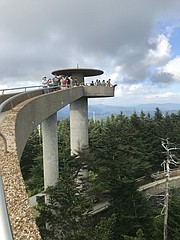If the U.S. Board on Geographic Names approves a proposal to change what is now named Clingmans Dome to its Cherokee name, Kuwohi, one of the effects below the surface would seemingly be financial as every guidepost, brochure, map, sign and website bearing information on the Great Smoky Mountains National Park landmark would have to be updated.
For the Clingman family, the question of cost is irrelevant.
"All three generations of my family and I are 100% in favor of restoring the name Kuwohi," said Tom Clingman, modern-day descendant of Thomas Lanier Clingman, the man for whom the peak is currently named.
"This name restoration is going to give the Cherokee people an opportunity to tell their story and share their culture with all of the visitors to Kuwohi," Clingman said in an email to the Chattanooga Times Free Press.
"Our country spent years trying to drive Native American culture away through forced assimilation programs," he said. "It is time that we as a society work with the Native Americans to ensure their stories, traditions and culture survive.
"Whatever the name change costs, it is a small price to pay to do what is right," Clingman said.
Maintenance costs
Until the work is taken up, the actual cost of a name change is hard to put on a receipt because many items are updated as they are reprinted, replaced or maintained, according to Dana Soehn, National Park Service spokeswoman for the Great Smoky Mountains National Park. And by updating the name change in that manner, the costs are curbed, too.
"I would think the cost would be negligible because we're always updating and reprinting," Soehn said Tuesday in a phone interview. "Even our signs, we're updating and replacing our entrance signs next year."
That way there will be no budgetary planning for the name change, she said. Soehn said there aren't that many wayfinding signs beyond the immediate area of the peak.
To the Cherokee, the name of the mountain has always been Kuwohi, which means "the mulberry place" in Cherokee.
The mountain was dubbed Clingmans Dome by the federal government in 1859, named for North Carolina Sen. Thomas Lanier Clingman, who played a role in exploring and surveying area mountains.
(READ MORE: Renaming Army bases that honor Confederates would cost $21 million)
Two years after the peak was named in his honor, Clingman -- who served as a Confederate general -- was expelled from the U.S. Senate in absentia for "conspiracy for the destruction of the Union and Government."
On July 14, the Eastern Band of Cherokee Indians Tribal Council in Cherokee, North Carolina, unanimously passed a resolution proposing the original Cherokee name for the mountain just over the North Carolina state line be restored. The effort is gaining momentum with support from surrounding governments.
For the Eastern Band, the mountain is culturally, historically and spiritually important, and the name Kuwohi goes back thousands of years, according to tribal member Lavita Hill, who with fellow tribal member Mary "Missy" Crowe drafted the resolution passed by the Tribal Council. Hill works as a treasury specialist for the tribe in Cherokee.
"Cherokee people have occupied these mountains for well over 10,000 years," Hill said in September in an email on the proposed change. "For over 10,000 years, Cherokee people called the mountain Kuwohi."
Cherokees historically named land features in that way, according to Hill. A mountain might have been known as Rattlesnake Mountain because rattlesnakes were found there. The same is true for the Cherokee peak of interest relating to mulberries.
"Mulberries were gathered at the base of the mountain -- typically below 3,000 feet -- and mulberries have many uses in traditional Cherokee medicine," Hill said in September. The native fruit is still harvested today.
Name change process
Soehn said the process for reviewing requests to change geographic place names is coordinated through the U.S. Board on Geographic Names, and individuals and groups proposing a name change submit requests for review.
"Then, they will reach out to the land managers and stakeholders relevant to the request for comment," Soehn said. "We anticipate that the U.S. Board of Geographic Names will reach out to us for comment, along with other stakeholders, after the official request is submitted."
Federal park officials are responsible for providing a holistic understanding of how people explored, used and lived in the mountains before the park was established, she said.
"The review of this request will provide an opportunity to consider a place name that might better represent the rich history of the highest peak in the Smokies, and we look forward to being a part of the process," she said.
'Smokies' example
In 2019, Great Smoky Mountains National Park officials were asked by U.S. Board on Geographic Names to consider renaming Injun Creek in the Greenbrier section of the park in Tennessee. According to information published in "Place Names of the Smokies" in 1999, the name recommended to the nomenclature committee was "Engine Creek" when an effort was made to remove duplicate geographic names in the park in the 1930s.
Soehn offered an excerpt from that publication:
"This stream was formerly called Indian Creek. However, the name change may have been misheard or misunderstood by cartographers who likely got it verbally from locals. Or, some of the blame may be attributed to one of the two Smoky Mountain nomenclature committees who worked in the 1930s and 1940s to standardize the names of places with more than one name or to eliminate duplicate names within the park. It is believed that the new name was given to the stream after a steam 'engine' derailed and crashed into this creek in the 1920s. What should have been called 'Engine' Creek (if that was its intended origin) was mistakenly given the derogatory moniker of Injun Creek."
Soehn said federal officials decided in favor of the historical event.
"We officially supported renaming the creek to 'Engine Creek' and were notified on March 16, 2020, that the name was approved," she said. "As we make reprints of maps and books, you'll see this name change reflected."
(READ MORE: White House says Mount McKinley to be renamed Denali)
Contact Ben Benton at bbenton@timesfreepress.com or 423-757-6569. Follow him on Twitter @BenBenton.

